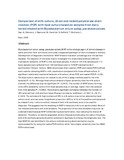| dc.description.abstract | Mycobacterium avium subsp. paratuberculosis (MAP) is the etiologic agent of
Johne's disease in cattle and other farm ruminants, and is also a suspected
pathogen of Crohn's disease in humans. Development of diagnostic methods for MAP
infection has been a challenge over the last few decades. The objective of this
study was to investigate the relationship between different methods for detection
of MAP in milk and fecal samples. A total of 134 milk samples and 110 feces
samples were collected from 146 individual cows in 14 MAP-infected herds in
southwestern Ontario. Culture, IS900 polymerase chain reaction (PCR) and nested
PCR methods were used for detecting MAP in milk; results were compared with those
of fecal culture. A significant relationship was found between milk culture,
direct PCR, and nested PCR (P < 0.05). The fecal culture results were not related
to any of the 3 assay methods used for the milk samples (P > 0.10). Although
fecal culture showed a higher sensitivity than the milk culture method, the
difference was not significant (P = 0.2473). The number of MAP colony-forming
units (CFU) isolated by culture from fecal samples was, on average, higher than
that isolated from milk samples (P = 0.0083). There was no significant
correlation between the number of CFU cultured from milk and from feces (Pearson
correlation coefficient = 0.1957, N = 63, P = 0.1243). The animals with high
numbers of CFU in milk culture may not be detected by fecal culture at all, and
vise versa. A significant proportion (29% to 41%) of the positive animals would
be missed if only 1 culture method, instead of both milk and feces, were to be
used for diagnosis. This suggests that the shedding of MAP in feces and milk is
not synchronized. Most of the infected cows were low-level shedders. The
proportion of low-level shedders may even be underestimated because MAP is killed
during decontamination, thus reducing the chance of detection. Therefore, to
identify suspected Johne's-infected animals using the tests in this study, both
milk and feces samples should be collected in duplicate to enhance the diagnostic
rate. The high MAP kill rate identified in the culture methods during
decontamination may be compensated for by using the nested PCR method, which had
a higher sensitivity than the IS900 PCR method used. | en |

